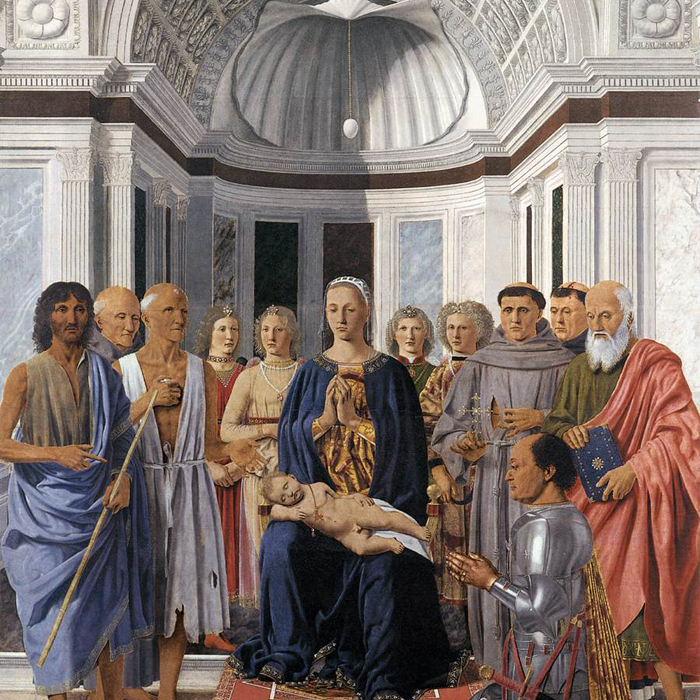Piero della Francesca, Italian painter considered a master among geniuses, was born in Borgo San Sepolcro, a tiny village in Tuscany, at an uncertain date between 1412 and 1416. He died, however, on a famous date in U.S. history, October 12, 1492, when Columbus reached San Salvador and opened up the European exploration of North America. To Piero, art meant the aesthetic form of mathematics, harmony, geometrism, light, and pure rationality. His rigorous and mathematical painting has inspired the art of several great authors.

Piero was one of the most influential artists of his time: His art provided suggestions to many painters of the next generation, some of whom, like Luca Signorelli and Perugino, were his direct pupils, while others, such as Raffaello Sanzio, Antonello da Messina, Giovanni Bellini, and Melozzo da Forlì were also linked to him. We know few details about Piero’s life. While working with maestro Domenico Veneziano in 1445, at the age of thirty-three, he had already commissioned his first important work, namely the Politico della Misericordia (The Mercy’s Polyptych).
Several of this master’s works mentioned in sources have been lost, and the dates of several of his paintings are not certain. He was an itinerant artist, even when associated with the cultural climate of Urbino, the city where he stayed between 1469 and 1472 under the reign of Duke Federico da Montefeltro, an art lover who commissioned him to paint a true masterpiece: the dual portrait of Federico and his wife Battista Sforza. This 1472 treasure is now kept in the Uffizi Museum in Florence. Though an absolute icon in the duke’s world as well as friend and collaborator of famous mathematician and architect Luca Pacioli, Piero’s horizons ranged even further.

When in Milan, we suggest you pay a visit to the Pinacoteca di Brera Museum where you can admire and never forget the Montefeltro altarpiece, Piero’s most famous masterpiece. In the painting he depicts a “sacred conversation” where the Madonna resembles Federico da Montefeltro’s wife (portrayed kneeling with her hands clasped, in adoration), and the Baby Jesus is none other than Guidobaldo da Montefeltro, the couple’s son.The painting stands out for the study of architecture, light (remarkable reflections on the armor of Federico that suggest a circular light, which therefore refers to the egg hanging over the characters), and for the geometric simplification of the figures, so much so that this work is considered a sort of synthesis of Piero's art.

The egg at the center of the imposing architecture of the setting is a symbol of the Immaculate Conception, therefore a symbol of the Madonna, and is also the pivot of Piero's theological reflection: The idea of inserting the Madonna and Child in a church was in fact of Flemish origin, and the purpose was to express the identification between Mary and the Roman Catholic Church.
In 1474 Piero finished the Montefeltro Altarpiece, currently preserved in Milan’s Pinacoteca di Brera, while the Madonna of Senigallia dates back to about 1478. In 1479 he returned to his home town Borgo San Sepolcro and produced few paintings in the following years. His most famous treatise, De prospectiva pingendi (On the Perspective of Painting), dates back to about 1480, while around 1481 he executed the Nativity of Christ, now in London’s National Gallery. In 1482 he was in Rimini where he wrote, ‘De quinque corporibus regularibus,” a treatise on Euclidean geometry, which he finished in 1485.
Barbara Benzoni
Barbara Benzoni was born in Milan and lives between Rome and Tuscany. She is devoted to USA, the land of courage and innovation. She’s Peter's super-lucky mum and Ale's wife. Cinema, art, good food and only beautiful things are the themes of her existence. With a degree in Italian literature and a Masters in Sports Management she can both enjoys books and basketball matches. In 25 years she has been organizing sport events all over the world and she’s been lucky enough to meet the greatest champs ever. Curiosity in everyday life and people are her drivers. Her personal icon is Mohammed Ali : "It's not bragging if you can back it up".

